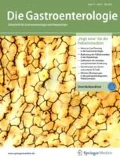Zusammenfassung
Mangelernährung im Alter ist häufig und als hochrelevanter, unabhängiger Risikofaktor mit vielen signifikanten klinischen Folgen assoziiert. Für eine effektive Behandlung steht das klinisch etablierte Stufentherapieschema zur Verfügung, bei dem die künstliche Ernährung über eine PEG-Sonde erst am Ende der Therapiekaskade steht. Die Durchführung einer PEG-Sondenernährung im Alter bedarf immer einer medizinischen wie ethischen Indikation und erfolgt nach individuell kritischer Abwägung. Nach unserem heutigen Schlüsselverständnis ist die Ernährung über eine PEG-Sonde vom Charakter her supportiv, frühzeitig, präventiv und passager. Ältere, multimorbide Patienten mit fortgeschrittener Demenz sind mit sehr seltenen Ausnahmen keine Indikation für die Durchführung einer künstlichen Ernährung. Die Anlage einer PEG-Sonde ist keine terminale oder gar symbolische Maßnahme bei Patienten am Ende des Lebens oder einer infausten Grunderkrankung.
Abstract
Malnutrition is a frequent and highly relevant independent risk factor in elderly people with significant clinical consequences. Individual adequate nutritional intervention is based on the established step-wise treatment algorithm where artificial nutrition via percutaneous endoscopic gastrostomy (PEG) tubes stands at the end of the therapeutic options. Placement of PEG tubes requires a clear medical indication as well as ethical justification within a critical, individual decision-making process. To our present knowledge, nutrition via PEG is from its character supportive, early, preventive and mainly transient but should not be placed in very old, multimorbid and demented patients. Artificial nutrition with a PEG tube is not a terminal or even a symbolic treatment at the end of human life or in patients with progressive stages of incurable diseases.



Literatur
Kaiser MJ, Bauer JM, Rämsch C et al (2010) Frequency of malnutrition in older adults: a multinational perspective using the mini nutrtitional assessment. J Am Geriatr Soc 58: 1734–1738
Heseker H, Stehle P (2008) Ernährung älterer Menschen in stationären Einrichtungen (ErnSTES-Studie). In: Deutsche Gesellschaft für Ernährung (Hrsg) Ernährungsbericht 2008. Frankfurt am Main, S 157–204
Löser C, Lübbers H, Mahlke R et al (2007) Der ungewollte Gewichtsverlust des alten Menschen. Dtsch Ärztebl 49: 3411–3420
Volkert D, Sieber CC (2011) Mangelernährung in der Geriatrie. Aktuel Ernährungsmed 36: 175–190
Löser C (2012) Malnutrition im Alter. Verdauungskrankheiten 29: 282–289
Volkert D, Lenzen-Großimlinghaus R, Krys U et al (2004) Leitlinien enterale Ernährung der DGEM und DGG – Geriatrie. Aktuel Ernährungsmed 29: 198–225
Volkert D, Berner YN, Berry E et al (2006) ESPEN Guidelines on enteral nutrition: geriatrics. Clin Nutr 25: 330–360
Löser C (2011) Grundprinzipien der Therapie – etablierte Allgemeinmaßnahmen. In: Löser C (Hrsg) Unter- und Mangelernährung – Klinik – moderne Therapiestrategien – Budgetrelevanz. Thieme, Stuttgart S 97–108
Milne AC, Potter J, Vivanti A et al (2009) Protein and energy supplementation in elderly people at risk from malnutrition. Cochrane Database of Systematic Reviews (2): CS003288
Stratton RJ, Elia M (2007) Who benefits from nutritional support: what is the evidence? Eur J Gastroenterol Hepatol 19: 353–358
Löser C (2010) Unter-/Mangelernährung im Krankenhaus – Klinische Folgen, moderne Therapiestrategien – Budgetrelevanz. Dtsch Ärztebl Int 107: 911–917 (doi: 10.3238/arztebl.2010.0911)
Stratton RJ, Elia M (2007) A review of reviews: a new look at the evidence for oral nutritional supplements in clinical practice. Clin Nutr 26 (Suppl 1): 5–23
Löser C, Aschl G, Hébuterne X et al (2005) ESPEN Guidelines on artificial enteral nutrition – Percutaneous endoscopic gastrostomy (PEG). Clin Nutr 24: 848–861
Löser C (2011) Ernährung am Lebensende – Palliativmedizin, das „PEG-Dilemma“. In: Löser C (Hrsg) Unter- und Mangelernährung – Klinik – moderne Therapiestrategien – Budgetrelevanz. Thieme, Stuttgart, S 341–355
Löser C, Fölsch UR (1996) Guidelines of the German Assoiciation of Gastroenterology (DGVS) Percutaneous endoscopic gastrostomy (PEG). Z Gastroenterol 34: 637–641
Löser C, Herz U von, Küchler T et al (2003) Quality of life and nutritional state in patients on home tube feeding. Nutrition 19: 605–611
Löser C, Wolters S, Fölsch UR (1998) Enteral long-term nutrition via percutaneous endoscopic gastrostomy (PEG) in 210 patients: a four-year prospective study. Dig Dis Sci 43: 2549–2557
Bannermann E, Pendlebury J, Phillips F et al (2000) A cross-sectional and longitudinal study of health –related quality of life after percutaneous gastrostomy. Eur J Gastroenterol Hepatol 12: 1101–1109
Senft M, Fietkau R, Iro H et al (1993) The influence of supportive nutritional therapy via percutaneous endoscopically guided gastrostomy on the quality of life of cancer patients. Support Care Cancer 1: 272–275
Löser C, Müller MW (1998) Ethical guidelines – percutaneous endoscopic gastrostomy (PEG tubes). Z Gastroenterol 36: 475–478
Casarett D, Kapo J, Caplan A (2005) Appropriate use of artifical nutrition and hydration – fundamental principles and recommendations. N Engl J Med 353: 2607–2612
Angus F, Burakoff R (2003) The percutaneous endoscopic gastrostomy tube: medical and ethical issues in placement. Am J Gastroenterol 98: 272–277
Sullivan JR (1993) Accepting death without artificial nutrition or hydration. J Gen Intern Med 8: 220–224
Finucane TE, Christmas C, Travis K (1999) Tube feeding in patients with advanced dementia. JAMA 282: 1365–1370
Gillick MR (2000) Rethinking the role of tube feeding in patients with advanced dementia. N Engl J Med 342: 206–10
Vitale CA, Hiner T, Ury WA et al (2006) Tube feeding in advanced dementia: an exploratory survey of physician knowledge. Care Manag J 2: 79–85
Holtappels P (2011) Juristische Aspekte. In: Löser C (Hrsg) Unter- und Mangelernährung – Klinik – moderne Therapiestrategien – Budgetrelevanz. Thieme, Stuttgart, S 206–214
Interessenkonflikt
Der Autor gibt an, dass kein Interessenkonflikt besteht.
Author information
Authors and Affiliations
Corresponding author
Rights and permissions
About this article
Cite this article
Löser, C. PEG im Alter. Gastroenterologe 7, 314–319 (2012). https://doi.org/10.1007/s11377-012-0661-2
Published:
Issue Date:
DOI: https://doi.org/10.1007/s11377-012-0661-2

